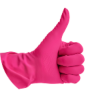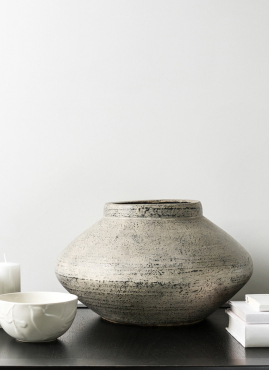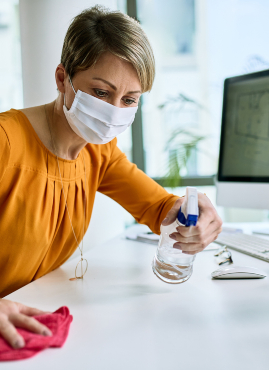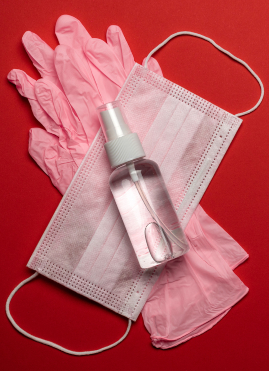 Start by looking at your reception/retail area and treatment rooms with a fresh eye. Think about having bare, easy-to-clean surfaces; you will be doing a lot of cleaning going forward. Give your space a deep clean, and consider what you might need to add or remove to make your space safer.
Start by looking at your reception/retail area and treatment rooms with a fresh eye. Think about having bare, easy-to-clean surfaces; you will be doing a lot of cleaning going forward. Give your space a deep clean, and consider what you might need to add or remove to make your space safer.
Remove
 Remove any unnecessary items that don’t serve a purpose to your practice such as candles, magazines, and knick-knacks. Consider removing items (e.g., throw pillows, fabric-lined chairs, seat cushions) with surfaces that cannot be cleaned properly. There may be a time for these things to return to your space, but for now, think about every surface a client interacts with in your space and how you can keep those surfaces clean for the health of all your clients.
Remove any unnecessary items that don’t serve a purpose to your practice such as candles, magazines, and knick-knacks. Consider removing items (e.g., throw pillows, fabric-lined chairs, seat cushions) with surfaces that cannot be cleaned properly. There may be a time for these things to return to your space, but for now, think about every surface a client interacts with in your space and how you can keep those surfaces clean for the health of all your clients.- Remove all product testers and samples from your retail shelves and front desk counters. Create client signage: “Let me know if you want to sample this product.”
- Rethink seating in any waiting areas, both in regards to their cleanability and their spacing so that clients are 3–6 feet apart, per the CDC; stagger client appointment start and end times so there is no client overlap in the waiting area.
- Eliminate self-serve items, and move water-dispensers to a place where the esthetician controls their use.
Clean
 Do a deep clean of all spaces. Use an EPA-approved disinfectant and follow the manufacturer’s guidelines for safe, effective use. Establish a cleaning schedule for bathrooms within the spa that are accessible to clients (for example, every 20–30 minutes) and in a sole practitioner setting (wipe down bathroom surfaces after every client visit).
Do a deep clean of all spaces. Use an EPA-approved disinfectant and follow the manufacturer’s guidelines for safe, effective use. Establish a cleaning schedule for bathrooms within the spa that are accessible to clients (for example, every 20–30 minutes) and in a sole practitioner setting (wipe down bathroom surfaces after every client visit).- Wash all linens, rugs, blankets, and curtains thoroughly and clean any holding receptacles for dirty laundry. Consider if a laundry service would be helpful to you at this time. As customary, ensure you have a secure and covered way to store fresh linens and a separate lidded and lined receptacle for dirty linens.
- Clean bolsters, tables, chairs and/or stools, trollies and stations, and ensure all implements are disinfected and stored in a closed container as directed by the CDC and product manufacturer. Certain porous materials can start to break down with repeated chemical disinfectant use.
- Clean light fixtures and switches; doorknobs, doors, and door frames. Clean floors thoroughly.
Add
 Have hand sanitizer, cleaning wipes, and facial tissues available in all spaces. Have disposable paper towels or a standing wipe dispenser available to use when handling doorknobs.
Have hand sanitizer, cleaning wipes, and facial tissues available in all spaces. Have disposable paper towels or a standing wipe dispenser available to use when handling doorknobs.- Have a hard-surfaced, non-porous chair or large hard-surfaced/plastic basket for clients to put their clothes on/in. You do not want client clothing to be laid over soft furniture that the next client will then sit on as they remove their shoes or disrobe.
- Lidded trashcans that are operated by a foot-pedal will keep facial tissues and other waste products from remaining exposed to the treatment room air.
- If you have a restroom within your space, install no-touch soap and paper towel dispensers; add a lidded, foot-pedal trashcan. Place CDC handwashing guidance posters within your restroom.
- If you don’t have windows you can open in your client treatment spaces, consider adding a high-efficiency particulate air (HEPA) purifier. .Although there is no direct evidence yet that these types of air purifiers can reduce the transmission of COVID-19, their use with similar viruses indicates they might help in some situations, and it would be logical that these filters could reduce concentrations of COVID-19 particles that remain airborne.
 Remove any unnecessary items that don’t serve a purpose to your practice such as candles, magazines, and knick-knacks. Consider removing items (e.g., throw pillows, fabric-lined chairs, seat cushions) with surfaces that cannot be cleaned properly. There may be a time for these things to return to your space, but for now, think about every surface a client interacts with in your space and how you can keep those surfaces clean for the health of all your clients.
Remove any unnecessary items that don’t serve a purpose to your practice such as candles, magazines, and knick-knacks. Consider removing items (e.g., throw pillows, fabric-lined chairs, seat cushions) with surfaces that cannot be cleaned properly. There may be a time for these things to return to your space, but for now, think about every surface a client interacts with in your space and how you can keep those surfaces clean for the health of all your clients. Do a deep clean of all spaces. Use an
Do a deep clean of all spaces. Use an  Have hand sanitizer, cleaning wipes, and facial tissues available in all spaces. Have disposable paper towels or a standing wipe dispenser available to use when handling doorknobs.
Have hand sanitizer, cleaning wipes, and facial tissues available in all spaces. Have disposable paper towels or a standing wipe dispenser available to use when handling doorknobs.